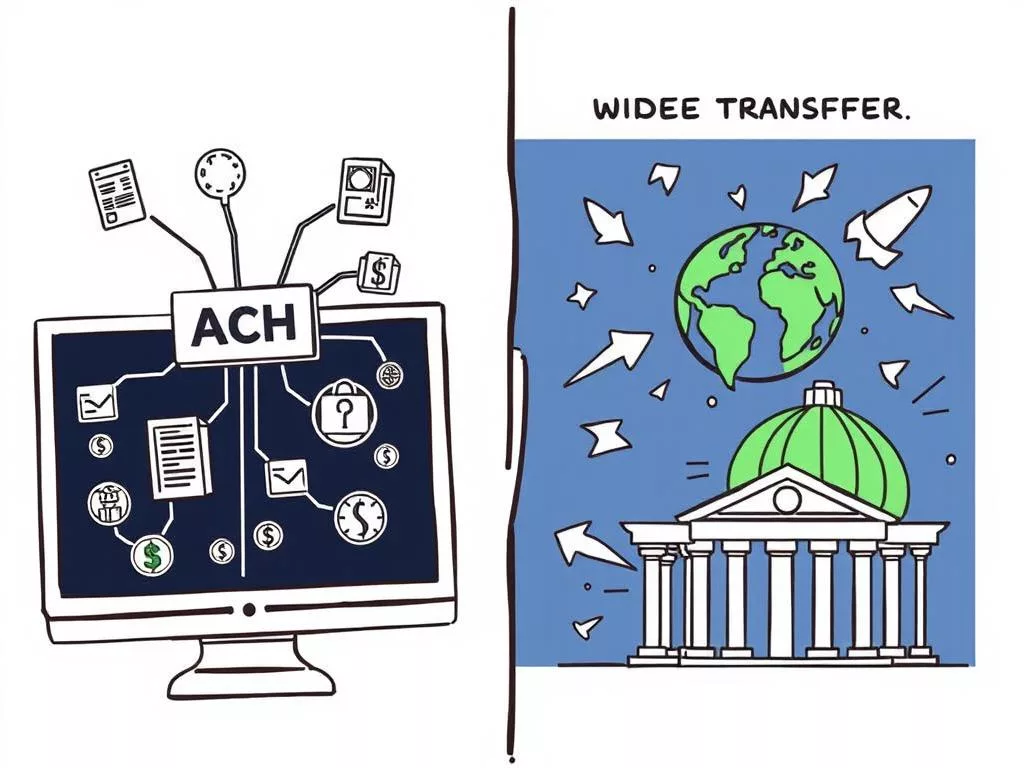In today’s digital world, knowing the differences in financial transactions is key. ACH (Automated Clearing House) and bank wire transfers are two main types. They differ in speed, cost, and how they’re used.
ACH transfers use a network of banks and are done in batches. They’re best for domestic, non-urgent payments, taking 1-3 business days. ACH is cost-effective, making it great for online bills and B2B payments.
Direct-deposit paychecks for 93% of Americans use ACH, showing its reliability and wide use.
Bank wire transfers are fast for urgent or big money moves. They go directly between banks or through SWIFT for global payments. Unlike ACH, they’re quicker, often in hours. But, they cost more, from $26 for domestic to $44 for international, for their speed and reliability.
In March 2022, over 18 million Fedwire transfers were made in the US. This shows the importance of knowing bank wire benefits. Each method has its own strengths, and the right choice depends on your needs.
Overview of ACH and Bank Wire Transfers
In the world of electronic fund transfers, ACH and bank wire transfers are key. They help move money safely. Knowing how they work can help you pick the best option for your money needs.
ACH transfers are great for direct deposits and regular payments because they’re cheap and reliable. They use a network to process transactions in batches. This takes one to three business days. ACH is perfect for non-urgent payments like bills or subscriptions.
Many ACH transfers don’t cost anything, which is a big plus in the US. This makes them popular for managing money.
Wire transfers, on the other hand, are fast, often done in minutes or hours. But they cost more. Domestic wires are $25 to $30, and international ones can be up to $50. Despite the cost, wire transfers are key for urgent, international payments.
Both ACH and wire transfers are secure, thanks to strict rules. But, each has its own risks. ACH can be slow due to cutoff times and holidays. It can also be a target for scams.
Wire transfers are fast but need careful checks to avoid fraud. They’re not reversible, which adds to the risk.

ACH and wire transfers are both vital for secure payments. Choosing between them depends on your needs. Consider how fast you need the transfer, the cost, and how safe it is.
For more on secure large bank transfers, check out this guide.
Guide to ach versus bank wire whats difference care
Choosing between ACH and wire transfer involves several key factors. Transaction speed is a big difference. Wire transfers are fast, often done in the same day. This makes them great for urgent needs.
ACH transfers, on the other hand, take 1 to 3 days. But, you can get same-day service for a fee.
Cost is another important factor. ACH is usually cheaper, often free for domestic use. Wire transfers, though, can cost between $25 and $50. This makes ACH better for regular, non-urgent payments like paychecks and bills.
International money transfers also vary. Wire transfers are best for quick international transfers. But, they can be pricey, sometimes taking up to 10 days and costing up to $50. ACH is mainly for domestic use and doesn’t work for international transfers.
Looking at volume, ACH is used a lot in the U.S. In the first quarter of 2024, it handled about 8.2 billion payments worth $20.7 trillion. Wire transfers, though fewer, are key for big transactions like buying a house or a car.
Here’s a detailed comparison to help in choosing ACH or wire transfer based on specific needs:
| Feature | ACH Transfer | Wire Transfer |
|---|---|---|
| Cost | Often Free | $25-$50 |
| Transaction Speed | 1-3 Days | Same Day |
| International Capability | Primarily Domestic | Yes |
| Use Cases | Bill Pay, Direct Deposits | High-Value Transactions |
| Fraud Risk | Lower | Higher |
| Reversibility | Possible | Very Difficult |
For a more in-depth understanding, check out this guide to international money transfers.
Key Use Cases for ACH and Wire Transfers
Knowing when to use ACH and wire transfers can help a lot in finance. Wire transfers are great for fast, secure money moves in real estate. They’re key when you need to transfer money right away. ACH transfers, on the other hand, are better for regular payments like payroll and taxes because they’re cheaper and reliable.
The ACH network handled 26.8 billion transactions in 2020. This shows it’s a big part of our daily money moves. For payroll, ACH is good because it’s cheap and consistent, costing about $0.29 per transaction. It settles most payments in one day, helping employees get paid on time.
For international payments, wire transfers are the best. They can send money across the world quickly, often in minutes for domestic transfers. This speed is critical in business where time is everything.

ACH payments are also very affordable, with fees from $0.25 to $1.75 per transaction. This makes them perfect for regular business payments. Wire transfers, though more expensive, offer unmatched speed and security.
Choosing between ACH and wire transfers depends on your needs. ACH is great for regular payments and payroll because it’s cheap and reliable. Wire transfers are best for fast, secure money moves in real estate and urgent international payments.
For more on international payments, check out this guide.
| Criteria | ACH Transfers | Wire Transfers |
|---|---|---|
| Best Use Cases | Payroll systems, recurring payments, government benefits | Real estate transactions, international business payments, urgent financial transfers |
| Transaction Time | 1-3 business days, Same-day option available | Minutes for domestic, up to 5 days for international |
| Cost | $0.25 – $1.75 per transaction; $0.29 average internal processing fee | Up to INR 2931.80 domestically, additional fees for international |
| Security | Disputable within set time frames | Irrevocable once processed |
Choosing Between ACH and Wire Transfers for Your Needs
Choosing between ACH and wire transfers depends on several things. These include how often you make transactions, the cost, and if you need to send money internationally. Knowing these points helps you pick the best option for moving money efficiently and safely.
ACH transfers are great for regular, high-volume transactions. They have low fees, usually around $0.29 per transaction. This makes them affordable for both businesses and individuals.
In 2020, the ACH network handled 26.8 billion transactions worth INR 5185.10 trillion. From 2015 to 2018, ACH payments grew by 6% each year. They’re perfect for non-urgent payments, settling in one banking day for 80% of them. ACH is also good for sending large amounts of money, like for payrolls or utility bills.
On the other hand, wire transfers are key for urgent, high-value, or international transactions. They use the SWIFT network, connecting over 11,000 banks in 200+ countries. Domestic wire transfers can take a day, while international ones might take up to five days. But, they’re faster and can be done in a day domestically or up to five days internationally.
Wire transfers are better for urgent needs because they’re faster, even though they cost more. For regular, high-volume transactions, ACH is the better choice because it’s cheaper. Think about speed, cost, and if you need to send money abroad to decide which is best for you.

